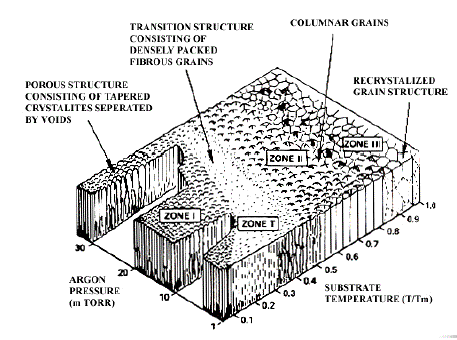During PVD coating processes such as magnetron sputtering and arc evaporation the film material is usually deposited atom by atom on a substrate by condensation from the vapour phase to the solid phase. This condensation step is not a random impingement of atoms that stick on the surface at the point of impact, due to the development of interatomic attractive forces, thermal mobility considerations and surface defects.
4 stages of coating growth
Generally a four stage dynamic process occurs. At first the nucleation of single atoms on the surface occurs. If the time of atom migration (determined by the atom’s energy) on the surface is great enough to meet another atom before being evaporated these atoms join together to form an island. As the energy required to evaporate one of the atoms from this pair is considerably higher than that needed for a separate atom stable islands (nuclei) start to form on the surface. The islands coalesce and finally the continuous growth of the film takes place.
Basic simulation of coating nucleation and growth
Substrate temperature and deposition rate affect coating density
If the atoms are deposited with a low substrate temperature the condensed atoms do not have enough kinetic energy and therefore surface mobility to jump across atomic steps and reach positions of a lower potential energy. A similar effect is also observed when high deposition rates are used. Adatoms do not have enough time to find lower energy sites before being covered by other atoms.
The Thornton structure zone model
The relationship between the substrate temperature, kinetic energy of the ions and the deposition rate has been summarised in various structure zone models. The most commonly used is the Thornton structure zone model (see below). This illustrates the relationship between the coating morphology, the deposition temperature and the pressure. In 1984 Messier, Giri, and Roy further refined the structure zone model.
The Thornton Structure Zone Model

